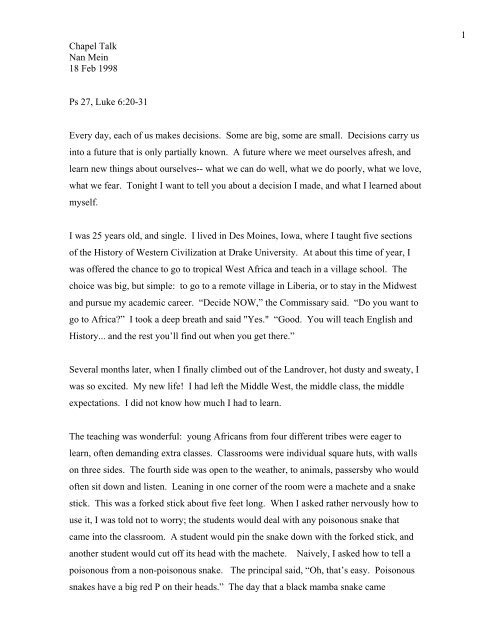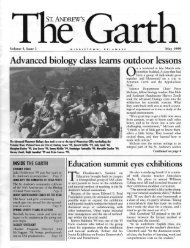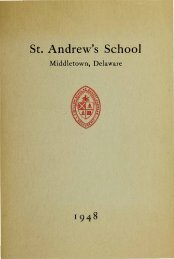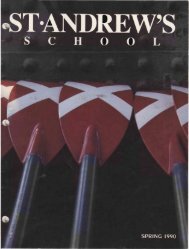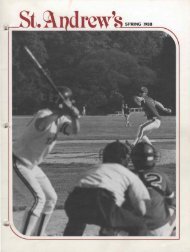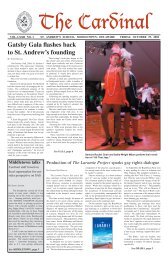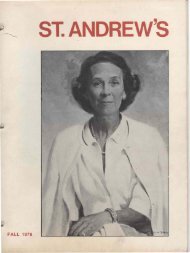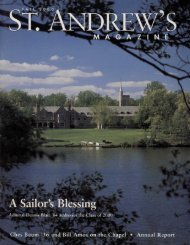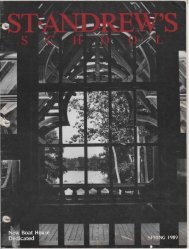1 Chapel Talk Nan Mein 18 Feb 1998 Ps 27, Luke 6:20-31 Every ...
1 Chapel Talk Nan Mein 18 Feb 1998 Ps 27, Luke 6:20-31 Every ...
1 Chapel Talk Nan Mein 18 Feb 1998 Ps 27, Luke 6:20-31 Every ...
Create successful ePaper yourself
Turn your PDF publications into a flip-book with our unique Google optimized e-Paper software.
<strong>Chapel</strong> <strong>Talk</strong><br />
<strong>Nan</strong> <strong>Mein</strong><br />
<strong>18</strong> <strong>Feb</strong> <strong>1998</strong><br />
1<br />
<strong>Ps</strong> <strong>27</strong>, <strong>Luke</strong> 6:<strong>20</strong>-<strong>31</strong><br />
<strong>Every</strong> day, each of us makes decisions. Some are big, some are small. Decisions carry us<br />
into a future that is only partially known. A future where we meet ourselves afresh, and<br />
learn new things about ourselves-- what we can do well, what we do poorly, what we love,<br />
what we fear. Tonight I want to tell you about a decision I made, and what I learned about<br />
myself.<br />
I was 25 years old, and single. I lived in Des Moines, Iowa, where I taught five sections<br />
of the History of Western Civilization at Drake University. At about this time of year, I<br />
was offered the chance to go to tropical West Africa and teach in a village school. The<br />
choice was big, but simple: to go to a remote village in Liberia, or to stay in the Midwest<br />
and pursue my academic career. “Decide NOW,” the Commissary said. “Do you want to<br />
go to Africa” I took a deep breath and said "Yes." “Good. You will teach English and<br />
History... and the rest you’ll find out when you get there.”<br />
Several months later, when I finally climbed out of the Landrover, hot dusty and sweaty, I<br />
was so excited. My new life! I had left the Middle West, the middle class, the middle<br />
expectations. I did not know how much I had to learn.<br />
The teaching was wonderful: young Africans from four different tribes were eager to<br />
learn, often demanding extra classes. Classrooms were individual square huts, with walls<br />
on three sides. The fourth side was open to the weather, to animals, passersby who would<br />
often sit down and listen. Leaning in one corner of the room were a machete and a snake<br />
stick. This was a forked stick about five feet long. When I asked rather nervously how to<br />
use it, I was told not to worry; the students would deal with any poisonous snake that<br />
came into the classroom. A student would pin the snake down with the forked stick, and<br />
another student would cut off its head with the machete. Naively, I asked how to tell a<br />
poisonous from a non-poisonous snake. The principal said, “Oh, that’s easy. Poisonous<br />
snakes have a big red P on their heads.” The day that a black mamba snake came
slithering over the back wall, I learned how fast I could run. I watched the beheading of<br />
the deadly snake from a cautious distance. And everyone in the class had snake for<br />
supper.<br />
2<br />
The girls’ dorm which I supervised was another world, another culture. On weekends I<br />
walked from village to village with an interpreter, holding adult literacy classes-- another<br />
teaching challenge. The other part of my routine was the weekly visit to the leper colony,<br />
Mbalatahun, town of healing.<br />
Leprosy-- the wasting disease feared around the world, throughout history. Its proper<br />
name is Hanson’s Disease. Earlier this century, a cure was discovered, and medication<br />
taken regularly would halt the disease. But if unchecked, leprosy is contagious. It is<br />
spread by touch.<br />
In 1925, when American Episcopalians arrived to start the Holy Cross Mission, they<br />
founded schools and a hospital. One day, taking a break, one of the Americans was<br />
strolling around the perimeter of the village. He saw a small path that he had not noticed<br />
before, leading away from the village through the tall grass. Where does it go Nowhere,<br />
he was told. He walked down the path a few hundred yards and came back. Who lives<br />
there No one, he was told. No person there.<br />
Curious, he went back. At the end of the path, in a little clearing, was a hut. A woman<br />
and her husband lived there; both were lepers. They had been members of a local family,<br />
but when they contracted leprosy, they ceased to exist. They ceased to be people. They<br />
became invisible. Their leprosy was quite advanced. The disease, which is painless,<br />
consumes tissue very slowly. Since it is contagious, the symptoms are usually first seen<br />
on hands. Fingers die, leaving clumps of hand bones. The nose, facial tissue, toes, feet:<br />
all die. These two lepers had little wheeled carts that had been made for them by their<br />
former family. They could kneel on them, and push themselves in and out of their hut and<br />
around their little clearing. Once a week, members of their former family brought food for<br />
them, leaving it at the edge of the clearing.
When the mission doctor heard of them, he said, “I wondered when we would find the<br />
lepers. We will build a town for them. Mbalatahun-- town of healing.” Word spread<br />
from village to village, and after a year or so, lepers began to appear-- some pushing<br />
themselves on their wheeled carts, others brought by their former families. All were given<br />
the magic tablets that arrested the disease. Fingers, toes, noses, flesh and bones would not<br />
grow back, but the disease was stopped. They lived with others like them. They had<br />
healthy children. They were people again, visible people, free to come and go, to shop in<br />
the big village on market day.<br />
3<br />
I told you that one of my weekly assignments was to go to the leper colony. Repair their<br />
wheeled carts, hand out clean dressings [bandages], help those who needed help in<br />
rewrapping their limbs, give out the weekly pills. Sounds OK I was terrified.<br />
I was full of fear. I was afraid to touch a leper. Afraid I would catch leprosy. Yes, I knew<br />
that everyone there was safe to touch, their leprosy under control. But I was rigid with<br />
fear. Afraid to touch. Ashamed of myself. I told myself, “These lepers are God’s poor--<br />
they have nothing, except the love of God. What kind of Christian are you” Each week I<br />
would go back to my house, hands stiff at my sides, my face streaming with sweat, afraid<br />
to wipe it off, to touch my nose, my mouth. I would wash my hands with disinfectant,<br />
scrubbing them again and again. Think of excuses why I couldn’t go next week. Papers<br />
to grade. Lessons to prepare. But next week always came. And my ugly fear. And my<br />
shame. This was a part of myself I hadn’t known about. Do unto others as you would<br />
have them do to you: is this how I would want to be treated if I had leprosy<br />
And then at a staff meeting, I heard that one of my 11th grade students had leprosy. “Not<br />
an advanced case,” we were told. “Just a small patch on his arm. He will stay at school<br />
and not move out to Mbalatahun.” I saw this boy every day! We greeted every day! The<br />
traditional greeting is to snap fingers. You can’t snap fingers if you’re a leper. Lepers<br />
were never greeted. Of course they were invisible. They were not people. But I had been<br />
snapping fingers with Peter Akoi for a year.<br />
I kept going to the leper colony, getting to know the people. And going home and<br />
washing obsessively, and acknowledging my failure. And then one day, at the weekly
market, the routine greetings. Issa...Issa....I reached out in response to “Issa, Teachah,”<br />
tried to snap fingers, and found none. “Oh,” I thought, “a leper.” And went on, looking<br />
for some fresh papaya. I realized that I had finally come to see these disfigured strangers<br />
as people. Persons like me. God loved them. God loved me. I had nothing to fear. My<br />
fear was taken away.<br />
4<br />
Today, leprosy has virtually disappeared. You read about it in the history of medicine.<br />
But there are invisible people in our world today. There are people on wheeled carts. In<br />
the USA there are 40 million people who are permanently disabled. One of them, the<br />
young golfer Casey Martin, made news two weeks ago. Under the Americans with<br />
Disabilities Act, signed into law by President George Bush in 1990, Casey Martin won the<br />
right to ride rather than walk during tournaments.<br />
I hope that when I have gone through another operation and have a new right knee, I will<br />
no longer need to use my wheelchair. But I have learned some new lessons since mid-<br />
November when my left knee collapsed and in an instant I became dependent on my<br />
wheeled cart. I have learned how a few stairs can be an insurmountable obstacle. How<br />
beautiful buildings can become exclusive clubs, and I’m not a member. How long it can<br />
take to do routine tasks, like getting through a door. How it feels to go shopping and have<br />
children stare at you. How it feels to be invisible to “abled” people.<br />
I began by talking about decisions and how they can teach us about ourselves. Tonight I<br />
ask you to think about decisions you make every day about how you treat other people.<br />
Many of us have experienced temporary disability as a result of athletic or other accidents.<br />
A longer term disability is possible for any of us. While you are healthy, examine your<br />
fears. Consider what you do when you act out of those fears. And consider how you treat<br />
those who are not like you-- the poor, the hungry, the disabled. Decide to act out of love,<br />
generosity, openness and concern rather than dislike and fear.<br />
Now is the time, in the words of St. <strong>Luke</strong>, to do unto others as you would have them do to<br />
you.


